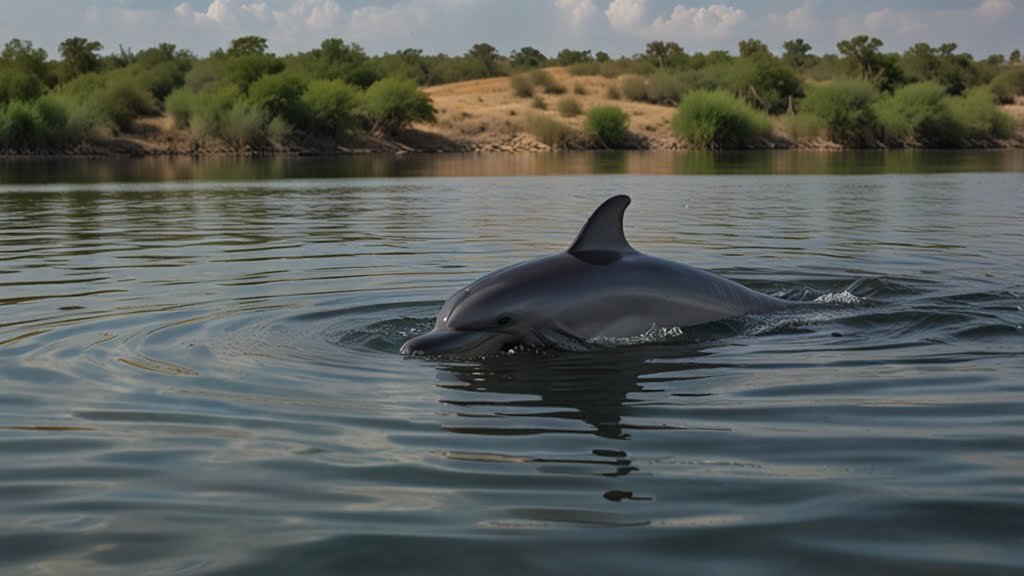The Indus River dolphin, known scientifically as Platanista gangetica minor, is one of the most unique and endangered freshwater dolphins in the world. Native to the Indus River Basin in Pakistan, this species faces significant threats that jeopardize its survival. In this article, we delve into the fascinating life of the Indus River dolphin, its ecological importance, and the conservation efforts aimed at saving this remarkable creature.

1. The Unique Characteristics of the Indus River Dolphin
The Indus River dolphins is distinguished by its long, slender body and a long, beak-like snout. Unlike many other dolphin species, it has adapted to life in freshwater and is specifically adapted to the murky waters of the Indus River. Key features include:
- Blindness: The Indus River dolphin is functionally blind. It relies on echolocation to navigate and hunt in the dark, sediment-laden waters of the river.
- Adaptations for River Life: With a flexible neck and a small dorsal fin, the Indus River dolphin can maneuver through the shallow and often turbulent river waters.
- Size and Color: Adults typically reach lengths of 2.5 to 2.7 meters (8 to 9 feet) and have a pale, pinkish-gray color.
2. Habitat and Distribution
The dolphin’s natural habitat is the Indus River and its tributaries in Pakistan. Historically, this dolphin was found throughout the Indus River Basin, but now its range is severely restricted due to human activities. The key areas where these dolphins are still found include:
- The Indus River: From the river’s northern regions near the Himalayan foothills to the southern areas approaching the Arabian Sea.
- Tributaries and Connected Waterways: Such as the Chenab, Jhelum, and Ravi rivers.
3. Threats to the Indus River Dolphin
The Indus River dolphin is critically endangered, with its population estimated to be fewer than 1,000 individuals. Major threats include:
- Habitat Fragmentation: Dams, barrages, and irrigation projects have fragmented the dolphin’s habitat, reducing the river’s flow and creating barriers to their movement.
- Water Pollution: Agricultural runoff and industrial waste pollute the river, affecting water quality and food sources.
- Bycatch: Dolphins often become entangled in fishing nets, leading to injury or death.
- Overfishing: Depletion of fish stocks affects the dolphins’ primary food sources.
4. Conservation Efforts
Several initiatives aim to protect and conserve the Indus River dolphin:
- Protected Areas: Establishing protected zones along the river where human activities are restricted.
- Anti-Poaching Measures: Implementing regulations to prevent illegal fishing and bycatch.
- Habitat Restoration: Efforts to restore and improve river habitats, including reducing pollution and managing water flow.
- Awareness and Education: Raising awareness about the importance of the Indus River dolphin and involving local communities in conservation efforts.
5. Fascinating Facts About the Indus River Dolphin
- Echoes in the Dark: Despite being blind, the Indus River dolphin can “see” using echolocation, emitting high-frequency clicks to locate prey and navigate through the murky water.
- Adapted to Freshwater: Unlike most dolphins, the dolphin has adapted to a completely freshwater environment.
- Historical Significance: The Indus River dolphin has been a part of the Indus River ecosystem for thousands of years, contributing to its unique biodiversity.
6. How You Can Help
- Support Conservation Organizations: Contribute to or volunteer with organizations working to protect the dolphin.
- Spread Awareness: Educate others about the importance of conserving this endangered species.
- Advocate for Policy Change: Support policies and projects that aim to preserve and restore the Indus River ecosystem.
Conclusion
The dolphin is a remarkable species, adapted to life in one of the world’s largest and most challenging river systems. However, its existence is under severe threat from human activities and environmental changes. Through dedicated conservation efforts and public awareness, we can work towards ensuring that this unique dolphin continues to thrive in its natural habitat. The preservation of the Indus River dolphin is not just about saving a species; it is about maintaining the health and balance of a vital river ecosystem that supports countless other forms of life.



